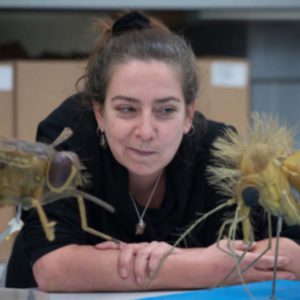
From the tips of their antennae to the end of their legs, fly morphology is as varied and diverse as their ecology and habitat. They have adapted to living up Mountains, in caves, and some have even made it into the sea – but these aren’t the most extreme habitats – and in doing so they have evolved into many a different and splendid form. We are now studying these much maligned creatures with renewed interest thanks to our thirst for bio-inspired technology, from healing our wounds to exploring the space above us, these mechanical marvels help us in more ways than we know.
BIOGRAPHY

Erica is the retiring President of the Amateur Entomology Society (UK), and sits on the committee for the Dipterists Forum (UK) and the International Congress of Dipterology. In 2016, her first book ‘The Secret Life of Flies’ was published, an award science book introducing flies to a new age which has received international acclaim across the globe, and this has been followed up by ‘The Inside Out of Flies’ published in 2020.
Erica studied Applied Environmental Biology for her undergraduate at the University of Manchester in the early 90’s. Whilst there she was able to undertake two placements; the first at the then Institute of Terrestrial Biology, where Erica ran around catching heather beetles on the Dorset Heaths and worked on their Dipteran parasites, followed by a placement at the University of Adelaide where she worked on ant communities in the South Australian Outback. Erica’s Doctorate was in wetland ecological entomology at the University of Roehampton. During her time researching this topic she turned to the taxonomic expertise that was housed in The Natural History Museum, London, and volunteered with them after she had completed her thesis.
After a period of lecturing in Ecology, Entomology and Biostatistics, mostly at Roehampton but also guest lecturing at various other Universities, Erica secured some contract work at the NHM. This turned into a maternity cover position, which in term led to a full time job in the Diptera Section in 2006, where she is now a Senior Curator. At the Museum, Erica is responsible for the Lower Brachycera, the Mycetophilidae, the Culicidae, as well as the Siphonaptera (flea) collection.
Links:
https://en.wikipedia.org/wiki/Erica_McAlister
https://www.discoverwildlife.com/author/ericamcalister/

